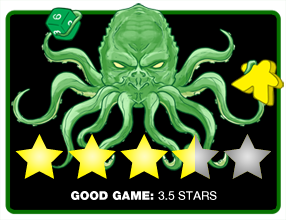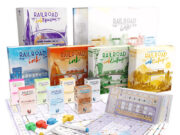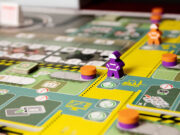 Welcome to the bustling bazaars of Tabriz! Within the four walls of the box of this new design from Randy Flynn (Cascadia fame), players are treated to a luxurious double-sided neoprene mat, nice tactile components, and an excellent insert to house it all. And according to the rulebook notes, this game has a pronunciation guide (Tabriz = ta BREEZ), listed cultural consultants, and even a fun little rating system for all its factors: luck, learning ease, strategy, and interaction. On the design side, things seem to be coming together nicely. Let’s look at how the lavish Persian carpetmaking weaves this all together in its gameplay.
Welcome to the bustling bazaars of Tabriz! Within the four walls of the box of this new design from Randy Flynn (Cascadia fame), players are treated to a luxurious double-sided neoprene mat, nice tactile components, and an excellent insert to house it all. And according to the rulebook notes, this game has a pronunciation guide (Tabriz = ta BREEZ), listed cultural consultants, and even a fun little rating system for all its factors: luck, learning ease, strategy, and interaction. On the design side, things seem to be coming together nicely. Let’s look at how the lavish Persian carpetmaking weaves this all together in its gameplay.
Gameplay Overview:
Tabriz is a game for one to five players all about fulfilling Persian carpet commissions. Setup sees certain tiles randomized by their location type with players beginning in the market square. Locations comprise of shops, courtyards, alleys, and traders, each with different purposes during play.
On a turn, a player takes one of their three apprentices and moves it up to three spaces away utilizing the location connections. Apprentices MUST move from their current location and cannot linger. After finishing movement, players take the location action and may complete a commission (re: contract) in their hand. After all players have taken actions with their apprentices, the round ends.

Each commission requires resources. There are five resource types in the game: wool, plant dye, camel hair, carmine dye, and silk. Once fulfilled, commissions provide immediate bonuses by way of coins, points, and skills. Many also provide ongoing bonuses that are offered at the beginning of each new round (called the workshop phase). Outside of contract fulfillment, the only points scored come from either ending the game by completing your ninth commission or by reaching the top of your skill track.
Locations matter. In each round, new resources emerge based on supply and demand. A shop that has no resources gains more, whereas shops overflowing in resources may sell out before you get there. Pricing varies based on supply and resource type. Beyond these shifting shops, trade locations provide ways to exchange goods in a pinch, and alley tiles provide a way to gamble for what you’re seeking. The two courtyard tiles provide silk and potential deals as well.
An example of play may see one player rushing to grab resources for a good price at one shop, while the next player resets their apprentice back to the market square to gain new commissions. And as commissions are completed, players gain more coin and begin to push their skill track higher. The skill track brings more lucrative commissions, better movement, as well as more commission flexibility.

There is variability with the alley tiles and courtyard tiles. These tiles provide a luck element by tasking players with rolling dice for goods. There are three dice types in the game, each with different values, and this gives some flexibility as well. As an example, the Foreign Merchant tile allows you to choose a resource, pay its cost, and then roll five dice. You then gain one resource per matching result. If you are lucky.
Tabriz also features solo opponents on the back of each of the five player mats. Each has a unique style of play that must be navigated while taking time to influence the bot’s dice pool via your own actions. This is a clever solo system and provides a lot to explore. There is also an Advanced Workshop Mode that tightens the efficiency puzzle by removing the market square income option.

Game Experience:
Tabriz is here to scratch your itch for resource conversion and action efficiency. Since the end game is determined by players, there is a constant tension of finding the best ways to complete the commissions that are available to you. Sometimes this may be by buying goods at a great price. Other times this may mean trading up for better resources. Or even, dare we say, gambling a bit?
It takes all kinds to make a carpet. Tabriz provides a little luck, a little strategy, a wee bit of interaction, and is easy to teach. The trickiest element here always returns to finding the most efficient way to complete commissions. And whether you like it or not, the commissions provide luck of the draw to keep the hunt for goods elusive.

The production from Crafty Games is great. This playmat is wonderful. Did I mention it fits in the box? Did I mention that the insert not only fits things nicely but also has a plastic cover to keep things in place? Did I mention that the resources have their own tray, and you can take it out and be ready to play? A lot of thought went into making this game easy to table.
There are some minor quibbles. I feel like the iconography for resources (and the associated color scheme) is a little rough. The player mats, which have that Chip Theory waterproof material, are much too large and don’t need to be so overproduced. The tiles added to the playmat feel like they come from another game—the woes of being basic. And the dice exacerbate the icon issue and could’ve used a color review.
On the gameplay side, turns are fast if you don’t invite the AP folx. The dynamic markets are great, though refreshing them each round is the worst (teamwork necessary). And watching players fail while gambling is always a hoot. The variability of all the tiles is excellent and helps you find the best fit for your group.

But something about the central movement mechanism bothers me.
Players start at the market square. They can return to the market square at the beginning of any turn. They have three movement per apprentice. It takes four movement to go from center to corner of the playmat. In a game about action efficiency, it feels like the movement puzzle is counter to everything else in the game. There is very little restriction based on movement save for not being able to visit the same tile twice in one round. No player blocking. No apprentice limitations. Nothing.
I can see that reducing movement may increase the length of the game. Why not shorten the contract end game? And the skill track? Once players gain the skill to move workers four spaces instead of three, the restrictions really disappear. As such, in the end, the individual commission puzzle can be a lot of fun, but the player interaction on the board (save for snatching resources from others) feels like an afterthought.
Final Thoughts:
Need a new Persian carpet? Have I found the game for you! Tabriz is half-strategy, half-race, as players hoover up resources and spit out happy customers. As an action efficiency puzzle, it’s wonderful. It doesn’t overstay its welcome and has enough nuance to wave at you from above the crowd. Plus, the production is top-notch.
But in my time playing the game, in solo, two, and three-player sessions, I always have that apprentice movement disconnect that really bothers me. Perhaps I need my Persian carpet to have a little more dynamism? Something beyond production to truly shine? Yeah, maybe something with a little more time being weaved together.
Final Score: 3.5 stars – Weave your way to victory in this resource conversion system that’s all about fulfilling those contracts.
 Hits:
Hits:
• Shifting markets
• Luxurious playmat
• Workshop residual actions
Misses:
• Fiddly shop resets
• Resource iconography
• Lack of restrictions





















